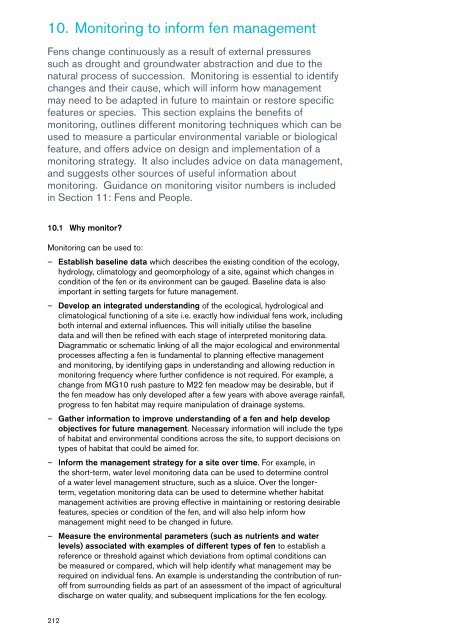Fen Management Handbook - Scottish Natural Heritage
Fen Management Handbook - Scottish Natural Heritage
Fen Management Handbook - Scottish Natural Heritage
You also want an ePaper? Increase the reach of your titles
YUMPU automatically turns print PDFs into web optimized ePapers that Google loves.
10. Monitoring to inform fen management<br />
<strong>Fen</strong>s change continuously as a result of external pressures<br />
such as drought and groundwater abstraction and due to the<br />
natural process of succession. Monitoring is essential to identify<br />
changes and their cause, which will inform how management<br />
may need to be adapted in future to maintain or restore specific<br />
features or species. This section explains the benefits of<br />
monitoring, outlines different monitoring techniques which can be<br />
used to measure a particular environmental variable or biological<br />
feature, and offers advice on design and implementation of a<br />
monitoring strategy. It also includes advice on data management,<br />
and suggests other sources of useful information about<br />
monitoring. Guidance on monitoring visitor numbers is included<br />
in Section 11: <strong>Fen</strong>s and People.<br />
10.1 Why monitor?<br />
Monitoring can be used to:<br />
– Establish baseline data which describes the existing condition of the ecology,<br />
hydrology, climatology and geomorphology of a site, against which changes in<br />
condition of the fen or its environment can be gauged. Baseline data is also<br />
important in setting targets for future management.<br />
– Develop an integrated understanding of the ecological, hydrological and<br />
climatological functioning of a site i.e. exactly how individual fens work, including<br />
both internal and external influences. This will initially utilise the baseline<br />
data and will then be refined with each stage of interpreted monitoring data.<br />
Diagrammatic or schematic linking of all the major ecological and environmental<br />
processes affecting a fen is fundamental to planning effective management<br />
and monitoring, by identifying gaps in understanding and allowing reduction in<br />
monitoring frequency where further confidence is not required. For example, a<br />
change from MG10 rush pasture to M22 fen meadow may be desirable, but if<br />
the fen meadow has only developed after a few years with above average rainfall,<br />
progress to fen habitat may require manipulation of drainage systems.<br />
– Gather information to improve understanding of a fen and help develop<br />
objectives for future management. Necessary information will include the type<br />
of habitat and environmental conditions across the site, to support decisions on<br />
types of habitat that could be aimed for.<br />
– Inform the management strategy for a site over time. For example, in<br />
the short-term, water level monitoring data can be used to determine control<br />
of a water level management structure, such as a sluice. Over the longerterm,<br />
vegetation monitoring data can be used to determine whether habitat<br />
management activities are proving effective in maintaining or restoring desirable<br />
features, species or condition of the fen, and will also help inform how<br />
management might need to be changed in future.<br />
– Measure the environmental parameters (such as nutrients and water<br />
levels) associated with examples of different types of fen to establish a<br />
reference or threshold against which deviations from optimal conditions can<br />
be measured or compared, which will help identify what management may be<br />
required on individual fens. An example is understanding the contribution of runoff<br />
from surrounding fields as part of an assessment of the impact of agricultural<br />
discharge on water quality, and subsequent implications for the fen ecology.<br />
212

















